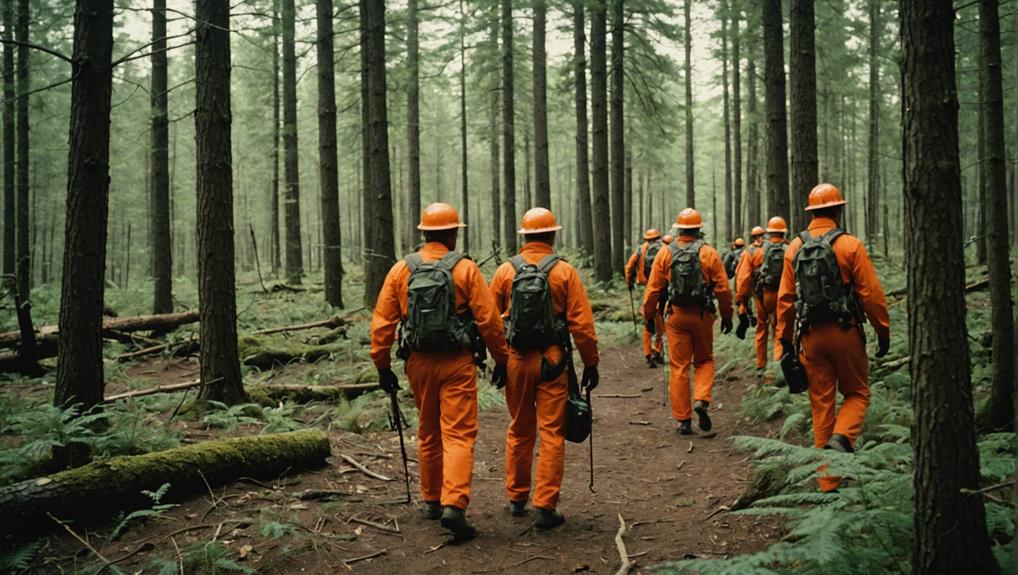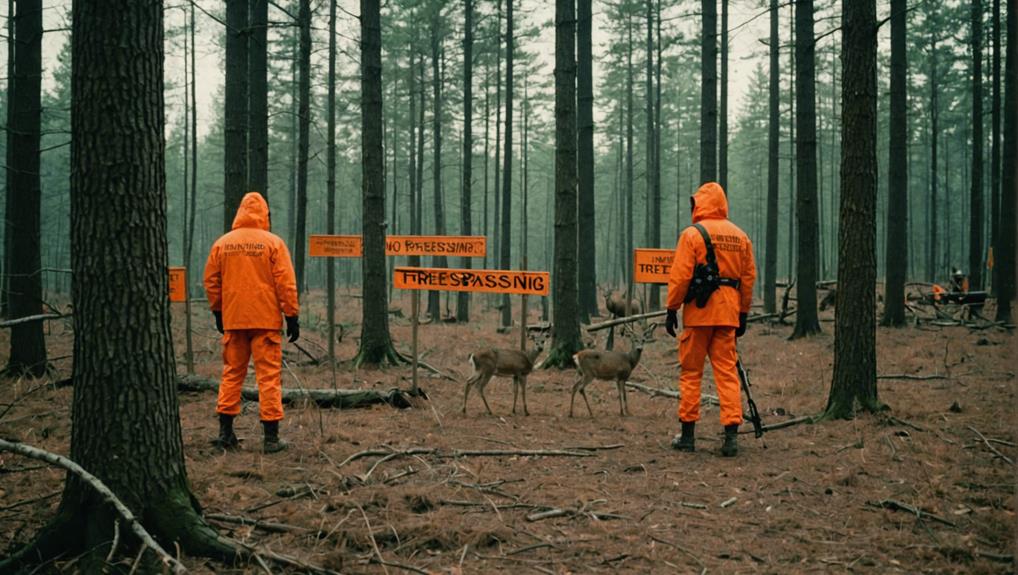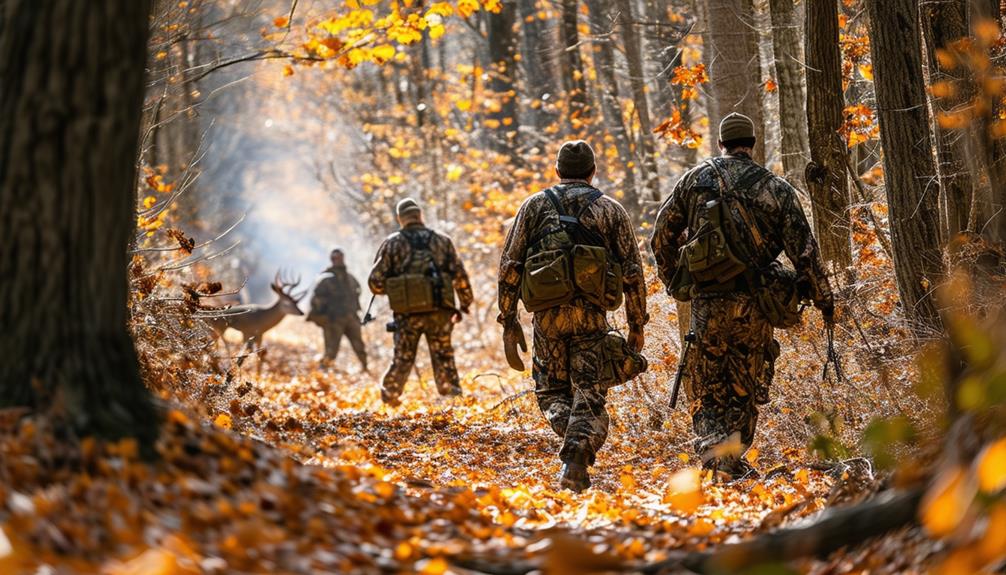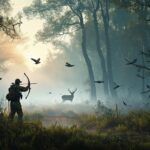A deer drive is an enthralling and time-honored hunting method where hunters and drivers join forces to flush deer from concealment towards a strategic line of marksmen. It demands impeccable organization and a keen understanding of deer behavior. Each member's role is carefully choreographed, underscoring a deep connection with nature and terrain. Hunters wear fluorescent orange for safety, and real-time communication guarantees precision. It's more than a hunt; it's a dance with nature, demanding both passion and meticulous execution. By mastering these elements, you'll appreciate the true art and tradition behind this exhilarating pursuit.
Key Takeaways
- Deer drives involve coordinated movement to push deer towards hunters.
- Drivers and spotters strategically position themselves across the terrain.
- Effective real-time communication is essential for coordination.
- Safety measures, such as wearing fluorescent orange, are vital.
- Deer drives showcase a blend of tradition, strategy, and unity.
Historical Background
Ever wondered how ancient hunters skillfully maneuvered in sync to corner their elusive prey? Deer drives, rooted deeply in traditional hunting practices, reveal the extraordinary prowess and unity of indigenous communities.
In these time-honored rituals, a collective of hunters would work together with remarkable precision and harmony to flush deer out from their concealed haunts.
Imagine the scene: hunters, familiar with every nook and cranny of their ancestral terrain, position themselves strategically around the wilderness. These hunters, known as 'drivers,' would advance through the landscape, creating a wave of movement and noise to push deer towards their awaiting companions.
The success of a deer drive depended not only on the hunters' intimate knowledge of the land but also on their ability to communicate and coordinate seamlessly. Each member knew their role and trusted the others to execute the plan flawlessly.
For centuries, this cooperative strategy has been a reflection of human ingenuity and collaboration. Deer drives aren't merely about the hunt; they're a dance of survival and freedom, showcasing the profound bond between people and nature.
Embracing these ancestral practices, you can glimpse a timeless connection to the wild and the enduring spirit of community.
Cultural Significance
The cultural significance of deer drives lies in their ability to blend ancient traditions with the modern ethos of community and cooperation. Imagine standing shoulder to shoulder with fellow hunters, each person playing an essential role, from trackers to drivers. This harmonious dance isn't just about the hunt but a confirmation of centuries-old practices that have stood the test of time.
When you participate in a deer drive, you're not just hunting; you're engaging in a ritual that embodies cultural heritage. Here's what makes it so special:
- Community Cooperation: Every successful deer drive hinges on seamless teamwork. Hunters coordinate their efforts, relying on each other's skills and knowledge.
- Traditional Hunting Techniques: The methods employed are often passed down through generations, preserving the essence of ancient practices while adapting to modern needs.
- Understanding Nature: A deep knowledge of deer behavior and movement patterns is crucial, highlighting the connection between the hunter and the natural world.
In essence, deer drives are a powerful blend of tradition and solidarity. They remind you that in the quest for freedom and sustenance, community and cooperation are your strongest allies.
Basic Principles
At the heart of a successful deer drive lies a blend of strategic planning and meticulous execution that brings both hunters and their prey into an intricate dance of pursuit and evasion. Imagine a group of hunters, bound by a shared purpose and an unspoken code, each playing a pivotal role in this age-old ritual. A deer drive isn't just a hunt; it's a symphony of movement and timing, where the harmony of organization guarantees the thrill of the chase.
The essence of a deer drive is simple yet profound. Hunters are divided into two key groups: drivers and posters. The drivers move through the terrain, using their knowledge of the land to flush deer from their hiding spots. Their goal is to guide the deer towards the posters, who wait in predetermined locations, ready for a potential shot. Every step, every whisper in the wind, is part of a grand strategy.
The success of a deer drive hinges on the group's ability to communicate and coordinate effectively. Safety measures, like wearing fluorescent orange, are critical, ensuring that freedom and safety walk hand-in-hand in this exhilarating pursuit.
Team Coordination
With the basic principles in mind, let's shift focus to the heartbeat of any successful deer drive: team coordination. This is where the magic happens, where freedom meets precision, and where every hunter's role is seamlessly intertwined with the next.
In a deer drive, impeccable organization and communication are paramount. Here's how you can achieve that:
- Pre-Hunt Planning: Gather your team to discuss the layout of the hunting grounds. Pinpoint the exact locations where drivers will push the deer and where posters will intercept them. Use maps and previous knowledge to strategize effectively.
- Real-Time Communication: Equip your team with radios or other communication devices. This guarantees everyone is aware of each other's positions and movements, reducing risks and increasing the chances of a successful hunt.
- Position Awareness: Safety is non-negotiable. Constantly update each other on your whereabouts. Knowing exactly where your fellow hunters are allows you to move with confidence and precision.
Roles and Responsibilities

In the grand orchestration of a deer drive, each hunter's role is pivotal.
You'll find spotters scanning for movement, drivers pushing deer into open spaces, and hunters strategically placed to intercept.
Your success hinges on understanding these responsibilities and executing them with precision and care.
Spotters' Key Duties
Recognizing the important role of spotters in a deer drive, you'll appreciate how their strategic positioning and constant communication with drivers guarantee not only a successful but also a safe hunt. The spotters' roles and responsibilities are essential to the entire operation, as they act as the eyes and ears of the team, ensuring the deer are intercepted effectively.
First and foremost, spotters must:
- Position Themselves Strategically:
You'll need to find an advantageous spot where you have a clear line of sight. This ensures you can take a precise shot when the deer, driven by the drivers, comes into view.
- Maintain Constant Communication:
Keeping in touch with the drivers is important. By doing so, you'll anticipate the deer's movement and adjust your position if necessary, which enhances the coordination and efficacy of the drive.
- Ensure Safety:
Safety can't be overstated. As a spotter, you're responsible for not just your own safety but also the safety of your fellow hunters. Clear communication and strategic positioning help minimize risks.
Effective spotters contribute significantly to the success of a deer drive, making it a well-organized and thrilling experience. Embrace this role with both passion and precision to fully enjoy the freedom and exhilaration of the hunt.
Drivers' Primary Tasks
Drivers in a deer drive play a pivotal role, as they carefully spread out across the terrain to push the deer out of cover and towards the waiting hunters. This task isn't merely about creating noise or chaos; it requires a deep understanding of the landscape and the behavior of the game. You, as a driver, must be attuned to the subtle nuances of the environment, traversing through forests, fields, and underbrush with purpose.
The success of a deer drive hinges on drivers' organization and coordination. Without a well-orchestrated effort, the deer might escape unnoticed. You'll need to communicate effectively with your fellow drivers, ensuring that every inch of the terrain is covered and that there are no gaps in the line. This synchronization is essential to gradually push game out of their hiding places, guiding them strategically towards the hunters.
Your goal isn't to make the deer run in panic, but to flush them out gently, creating a controlled movement. This delicate balance of pressure and patience exemplifies the art of a deer drive, showcasing a blend of strategy and skill that brings freedom to the wilderness.
Hunters' Strategic Positions
As drivers meticulously push deer out of their concealed habitats, hunters positioned strategically across the terrain stand ready to intercept and harvest the game. Your role as a poster is vital, requiring sharp focus and an intimate knowledge of the land. Terrain familiarity isn't just an advantage—it's essential. You've got to know every dip and rise, every hiding spot where a deer might seek refuge as it flees from the drivers.
Here's how you and your fellow hunters achieve success:
- Coordination: Each hunter must be aware of their designated position and the proximity of others. Safety and efficiency hinge on this awareness.
- Communication: Clear signals between drivers and posters ensure that no deer slips through the cracks and that everyone remains safe.
- Patience: As a poster, you must remain still and quiet, even when the wait feels endless. The slightest movement can alert a deer and spoil the drive.
Embrace the blend of skill and strategy that defines a deer drive. The freedom to roam the wild, to feel the pulse of the terrain beneath your boots, and to partake in this age-old practice is a privilege that demands respect and precision.
Planning the Drive
Effective planning for a deer drive starts with a thorough understanding of the terrain and meticulous coordination among all hunters. Every detail matters, from knowing the lay of the land to making certain that each participant is clear on their role. Safety considerations when hunting are essential; it's vital to guarantee that everyone is wearing fluorescent orange for visibility and that no one ever shoots in the direction of another hunter.
Planning the drive involves orchestrating the movements of drivers and posters with precision. Drivers spread out across fields or woods, pushing deer from their hiding places, while posters strategically position themselves to intercept the game. This coordination isn't just about success—it's about keeping everyone safe and maintaining the camaraderie that makes hunting a cherished pursuit.
Here's a quick overview to guide your planning:
| Aspect | Details |
|---|---|
| Terrain Knowledge | Familiarize with elevation changes, cover types |
| Hunter Coordination | Clear communication, role assignments |
| Safety Measures | Fluorescent orange gear, safe shooting zones |
Choosing the Location

With meticulous planning in place, the next step is choosing the perfect location where natural funnels or escape routes will enhance the success of your deer drive. You'll want to immerse yourself in the landscape, identifying those subtle pathways deer naturally follow. These areas become pivotal as they channel the deer into specific routes, increasing your chances of a successful drive.
To make sure you select the best location, consider these elements:
- Wind direction: Always be mindful of the wind. By positioning drivers and posters strategically, you can guide deer towards your chosen intercept points.
- Avoid dense cover: While thick brush might seem like a good hiding spot for deer, it can actually hinder their movement during a drive. Opt for areas where deer can move freely but still feel concealed.
- Strategic locations for posters: Place posters in areas where deer are most likely to emerge from their escape routes. These positions should offer clear lines of sight and easy access to the paths deer are funneled through.
Understanding the terrain and deer behavior is essential. Embrace the challenge and the freedom it offers. By choosing strategic locations, you turn the wilderness into an arena where skill and knowledge reign supreme.
Safety Precautions
Safety during a deer drive hinges on meticulous preparation and unwavering vigilance.
You must wear fluorescent orange to guarantee visibility, maintain constant communication with your fellow hunters, and always be aware of safe shooting zones.
Proper Gear Requirements
Guaranteeing your visibility during a deer drive is paramount, so always wear fluorescent orange gear. This vibrant color isn't just a fashion statement but a critical safety measure.
Here are the proper gear requirements you should adhere to:
- Fluorescent Orange Clothing: Head-to-toe fluorescent orange guarantees that every hunter in the area can easily spot you. This includes a hat, vest, and even gloves. The goal is to stand out vividly amidst the natural backdrop.
- Sturdy Footwear: Invest in high-quality, waterproof boots. The terrain during a deer drive can be unpredictable, ranging from muddy fields to rocky inclines. Proper footwear keeps you agile and safe.
- GPS and Mapping Tools: In the wilderness, your sense of direction can be easily compromised. A reliable GPS device or a detailed map ensures you always know where you're and where others might be.
Communication Among Hunters
While proper gear is fundamental, maintaining clear and constant communication among hunters is equally essential for a safe and successful deer drive. As you venture into the wild, the harmonious orchestration of your group relies heavily on the ability to relay instructions and signals effectively. This isn't just about barking orders; it's about fostering a symphony of movements, where every hunter knows their role and position, ensuring that accidents are avoided and game is pursued with precision.
You must always be aware of each other's locations. In the midst of a deer drive, where adrenaline surges and focus sharpens, losing track of a fellow hunter could spell disaster. Clear communication creates an invisible web of safety, binding the group together and preventing mishaps. This vigilance transforms the hunt from a chaotic scramble into a choreographed flow, where each step and gesture is intentional and understood.
Strategizing your deer drive becomes an art form when effective communication is in place. It's not just about speaking; it's about listening and responding, creating a dynamic interplay that enhances the entire hunting experience. Proper protocols and consistent updates reduce risks, ensuring that your drive isn't just successful, but also liberatingly safe.
Identifying Safe Zones
Marking safety zones with precision is paramount to ensuring that every hunter remains out of the line of fire during a deer drive. These designated areas are the sanctuaries where no shots are fired, providing a buffer that safeguards every participant's well-being. Establishing these safe zones is a dance of careful planning and impeccable communication, which is the heartbeat of a successful hunt.
First, assess the terrain to determine natural barriers that can serve as boundaries.
Second, clearly mark the designated areas using visible indicators such as flagging tape or brightly colored signs.
Third, ensure that everyone is aware of these boundaries through pre-hunt briefings and constant radio communication.
- Assess the terrain: Look for natural high ground or water bodies that can act as barriers.
- Clearly mark designated areas: Use flagging tape or signs to denote these zones.
- Ensure awareness: Conduct pre-hunt briefings and maintain communication during the hunt.
Equipment Needed

To maximize both safety and success during a deer drive, you need a carefully curated set of essential equipment. First and foremost, equip yourself with fluorescent orange clothing. This high-visibility gear is essential for ensuring that every hunter can easily be seen, reducing the risk of accidents in the dense woods where visibility is often compromised.
Next, maintain clear and constant communication with your fellow hunters using walkie-talkies. These devices are indispensable for coordinating movements, sharing sightings, and ensuring that everyone is aware of each other's positions. Effective communication can make the difference between a successful hunt and a dangerous misstep.
For your weapon of choice, a shotgun is highly recommended. Its wide spread can provide a greater margin for error, which is particularly beneficial in the dynamic and fast-paced environment of a deer drive. Additionally, consider bringing along deer calls or scents to lure your quarry closer, enhancing your chances of a successful hunt.
Lastly, a well-trained dog can be your most loyal and efficient companion. Their keen senses and agility can track and retrieve game that might otherwise be lost.
With the right equipment, you're not just prepared; you're empowered.
Modern Adaptations
In the ever-evolving world of hunting, modern adaptations have revolutionized the traditional deer drive, incorporating cutting-edge technology and refined strategies to enhance both safety and success.
You'll find that today's deer drives leverage advancements in communication and organization, making them more efficient than ever.
A key aspect of these modern adaptations is the use of technology. Radios and GPS devices have become essential tools, enabling hunters to stay connected and coordinate their movements seamlessly. This guarantees that everyone knows their role and location, greatly improving safety and effectiveness.
Safety precautions aren't taken lightly. Wearing fluorescent orange has become a standard practice to ensure visibility and prevent accidents. This vivid color distinguishes hunters from their surroundings, reducing the risk of misidentification.
To make the most of modern adaptations, focus on these three elements:
- Effective Communication: Utilize radios or GPS devices to maintain clear, constant contact.
- Safety Precautions: Always wear fluorescent orange and stay aware of your surroundings.
- Detailed Planning: Organize the drive meticulously, knowing the terrain and positions of all participants.
Legal Considerations

Understanding the labyrinth of hunting laws is indispensable for making sure your deer drive is both compliant and ethical. Each state or province crafts its unique tapestry of hunting regulations, making it paramount that you consult local laws before initiating a deer drive. These legal considerations aren't just bureaucratic hurdles—they're the foundation of responsible hunting.
Imagine the serenity of the wild, the crisp air filling your lungs as you and your companions position yourselves for the deer drive. This scene, filled with promise and anticipation, can quickly turn nightmarish if you falter in adhering to hunting regulations. An innocent oversight, like failing to obtain the correct permits or misunderstanding the legal hunting zones, can lead to hefty fines and legal repercussions that tarnish your experience.
A meticulous understanding of these legal requirements ensures a safe, respectful, and exhilarating hunt. It's a confirmation of your commitment to the craft and the environment.
Ethical Concerns
When you engage in a deer drive, it's essential to understand the impact on wildlife populations, ensuring that your actions don't disrupt the delicate balance of nature.
Prioritizing hunter safety isn't just a legal requirement; it's a moral duty to protect each participant.
Embracing fair chase principles means respecting the animal's chance to escape, making the hunt both ethical and honorable.
Impact on Wildlife Population
Deer drives, though a traditional hunting method, often spark intense ethical debates due to their significant impact on wildlife populations and the stress inflicted on the animals. When you engage in a deer drive, you're not just impacting a single deer; you're altering the entire ecosystem.
The ethical concerns surrounding this practice are multifaceted, focusing on both the welfare of the animals and the sustainability of their populations.
- Impact on wildlife population: Deer drives can disrupt natural behaviors, forcing deer to flee their habitats, which can lead to increased mortality rates and decreased reproductive success.
- Ethical concerns: The method raises questions about fair chase and humane treatment, as the stress inflicted on the animals can be immense. How do you reconcile the thrill of the hunt with the ethical obligation to minimize suffering?
- Deer population management: While some argue that deer drives help control overpopulation, others believe the practice is unsustainable and can lead to long-term ecological imbalance.
Understanding these ethical considerations is crucial for responsible hunting practices. By reflecting on the impact of deer drives, you contribute to a broader dialogue about wildlife conservation and the ethical treatment of animals.
Hunter Safety Issues
Exploring hunter safety during deer drives is essential, as the risks involved demand careful planning and strict adherence to safety protocols. The practice of pushing deer out of hiding places compels you to be vigilant about "safe hunters splits" to guarantee everyone's well-being. This involves positioning hunters at strategic intervals, maintaining visibility, and clear communication.
An important safety consideration is the use of brightly colored gear to distinguish hunters from the surroundings. This minimizes the risk of accidental shootings, a prevalent concern in dense woods. Additionally, every participant must be fully briefed on the plan and their specific roles, as deviations can lead to dangerous situations.
Understanding the potential risks and ethical implications of deer drives promotes a culture of responsibility among hunters. Let's explore some critical safety aspects:
| Key Safety Aspect | Description |
|---|---|
| Visibility Gear | Wear bright colors to stand out |
| Communication | Use radios or signals to coordinate |
| Positioning | Keep safe distances between hunters |
| Clear Roles | Everyone must know their role |
| Pre-Drive Briefing | Review the plan and safety rules |
Fair Chase Principles
Maintaining the principles of fair chase during a deer drive guarantees that the hunt respects the animal's natural behavior and promotes ethical hunting practices. You must make sure that the pursuit is conducted with respect for the deer and the environment. This means adhering to guidelines that keep the hunt sporting and just. Fair chase principles emphasize the importance of giving the deer a fair chance to evade hunters, which elevates the challenge and satisfaction of the hunt.
To uphold these principles in a deer drive, consider:
- Organization and Planning: A well-coordinated hunt reflects respect for the animal and the land. Familiarize yourself with the terrain and establish clear roles for drivers and posters.
- Safety Precautions: Safety is paramount. Wearing fluorescent orange ensures visibility and prevents accidents, fostering a secure environment for all participants.
- Ethical Hunting Strategy: The strategy shouldn't only be effective but also fair. Avoid overhunting and make sure the deer have ample opportunity to escape, preserving the integrity of the chase.
Success Strategies

Success in a deer drive begins with meticulous planning and a deep understanding of the terrain. To truly excel, you must weave safety precautions, organization, and terrain familiarity into the fabric of your strategy.
Imagine a symphony where each hunter plays an essential role, moving through the land like notes on a page. This orchestration demands everyone knows their part and the lay of the land.
Safety is paramount. Guarantee each member is well-versed in handling their equipment and maintains a clear line of communication. Small groups are preferable, minimizing risks and ensuring greater control.
Organization is the backbone—assign roles meticulously. Drivers should spread out strategically to push the deer towards the posters, who must be positioned at key intercept points.
Understanding the terrain is your compass. Familiarize yourself with every ridge, thicket, and trail. This knowledge not only guides your movements but also predicts the deer's. Your intimate connection with the land turns obstacles into opportunities.
When executed with precision and passion, a deer drive becomes more than a hunt—it's a dance with nature, a confirmation of your freedom and skill. Embrace the challenge, respect the game, and let the land guide you to success.
Personal Experiences
As you step into the world of deer drives, let me share a personal tale that underscores the thrill and camaraderie that define this age-old hunting practice. Picture a crisp autumn morning, the forest alive with anticipation. Our group, a mix of seasoned hunters and enthusiastic novices, gathered at dawn to discuss our strategy. The essence of deer drives lies in organization, and our plan was meticulously crafted.
- Strategic Spread: We drivers positioned ourselves across the terrain, ready to nudge the deer towards the posters.
- Familiar Terrain: Each of us knew the land intimately, understanding where the deer would likely break cover.
- Coordination: Constant communication was key, ensuring everyone moved in unison.
As the drive began, the forest transformed. The rustle of leaves and distant calls of fellow hunters filled the air. Adrenaline surged as I spotted movement, pushing the deer towards the waiting posters. The thrill of the chase was palpable, but safety precautions were paramount. Our fluorescent orange gear and clear signals guaranteed no one was in harm's way.
Deer drives are more than a hunt; they're a tribute to teamwork, strategy, and respect for nature.
Frequently Asked Questions
Which of the Following Best Describes a Hunting Practice Known as a Man Drive?
You'll find that a Man Drive involves group coordination, noise management, and hunter safety, where staggers and drivers work together to strategically drive deer toward waiting hunters, ensuring a successful and exhilarating hunting experience.
Which of the Following Best Describes the Practice of Still Hunting?
Imagine the thrill of still hunting: you silently track your prey, master camouflage strategies, and read the wind's whispers. This practice demands sharp tracking techniques, blending seamlessly into nature, and offers the ultimate test of freedom.
When Participating in a Deer Drive, What Is an Important Consideration That Drivers Should Remember?
When participating in a deer drive, you must prioritize driver coordination, using clear communication methods to establish safety zones. This guarantees everyone's safety, allowing you to enjoy the thrill of the hunt while preserving the freedom of the wild.
Which of the Following Best Describes the Code of a Hunter?
Coincidentally, the code of a hunter embraces ethical hunting, conservation efforts, and safety protocols. You must respect wildlife, abide by safety measures, and contribute to preserving nature. Such principles guarantee hunting remains a cherished tradition.
Conclusion
Imagine a symphony where each hunter is an instrument, their movements meticulously orchestrated to create a harmonious crescendo. In the grand theater of the wilderness, you play your part, guided by tradition and bound by camaraderie.
The deer drive is more than a hunt; it's a ballet of human and nature, a dance as ancient as time itself. Embrace its rhythm, respect its lore, and you'll find not just game, but a deeper connection to the world around you.





I find the discussion on the cultural significance of deer drives intriguing. It adds depth to our understanding of hunting practices.
I believe that the cultural significance of deer drives should not be overlooked. Its a tradition worth preserving and understanding.
I believe the cultural significance of deer drives should not be overlooked. Its a tradition worth preserving and understanding.
I believe the cultural significance of deer drives is often overlooked. Its not just about hunting but about community bonding and tradition.
Interesting read, but dont you think the cultural significance of deer drives could vary significantly across different global cultures?
Interesting read, but isnt the cultural significance of deer drive hunting often overlooked in favor of its historical background?
Interesting read, but isnt the historical context of deer drives overly simplified here? Surely, theres more to it.
Overly simplified? Perhaps, but isnt history itself a simplification of complex events?
Interesting read, but isnt this deer drive hunting method potentially disruptive to the natural movement and behavior of other wildlife? Just food for thought, guys. Lets not overlook the broader ecological impact.
Disruptive or not, its Survival of the Fittest out there. Nature always balances itself.
While I respect the historical and cultural significance of deer drives, isnt it time we reconsider this practice in the light of animal rights and conservation? Intriguing article though, stirred up quite a debate in my mind.
Isnt the cultural significance of deer drives undervalued? Its not just about hunting, but also about bonding and tradition, right?
Absolutely! Deer drives are more about cultural preservation than just hunting. Tradition matters!
Historical background, cultural significance, yet no mention of environmental impacts? A glaring omission in this deer drive discussion, dont you think?